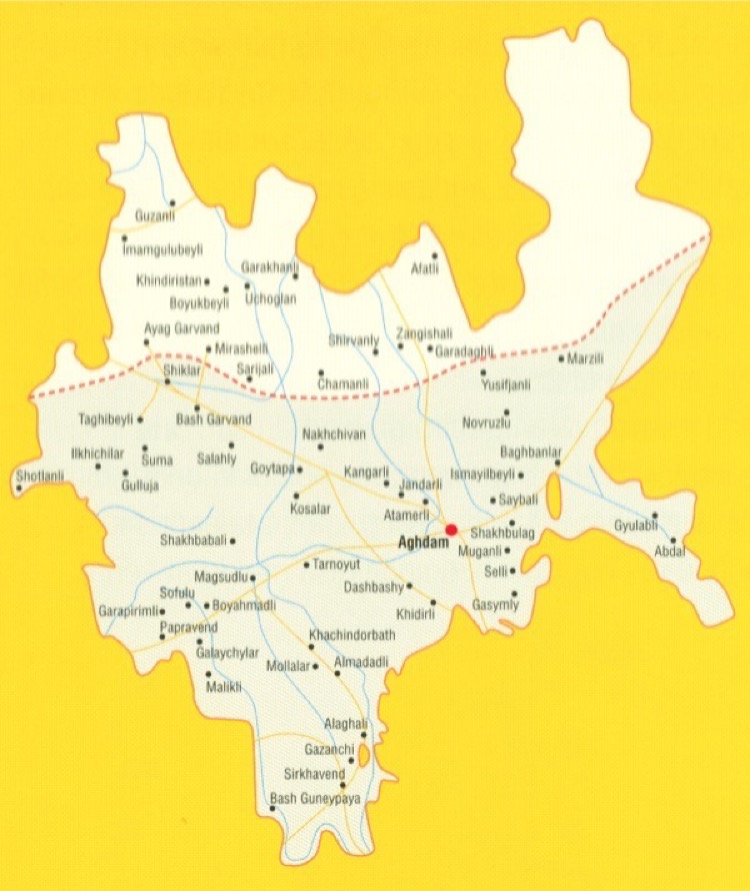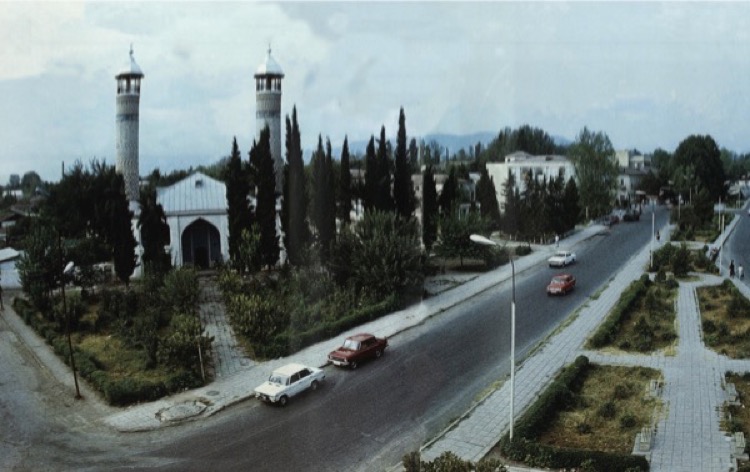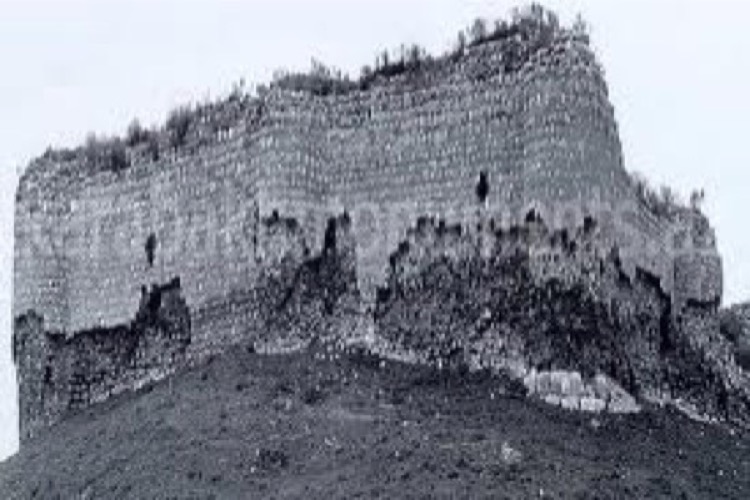Aghdam district is the administrative district of the Republic of Azerbaijan. It is located on the northern-eastern slopes of the Karabakh Chain of Mountains, in the south-western part of the Kura-Aras Lowland. Its area is 1150 km2; the population is 178,4 th. (01.01.2023). The central town is the city of Aghdam. On July 23, 1993 the Armenian military army occupied the city of Aghdam and the major part of this district. On November 20, 2020 the 73 percent of the district’s territory, including Agdam city was returned to Azerbaijan.
The district covers the followings: Aghdam city, Guzanli settlement, 17 newly constructed settlements (Guzanli, Ayagh Garvand, Khindiristan, Erghi, Alibayli-1, Alibayli-2, Banovshalar-390, Banovshalar-7, Safarli, Baharli, Dord yol-1, Dord yol-2, Tezekend, Gasimbayli, Imamgulubayli, Guzanli-1, Guzanli-689) and villages of Shotlanli, Shurabad, Umudlu, Gasimli, Gurdlar, Shelli, Poladli, Shukhbabali, Mughanli, Papravend, Garapirimli, Sarichali, Gullar, Garadagli, Gulabli, Abdal, Novruzlu, Kangarli, Shirvanli, Garagashli, Yusifjanli, Goytepe, Javahirli, Kosalar, Abdunlu, Sirkhevend, Garashlar, Bashirler, Melikli, Bash Guneypeye, Yeni Garalar, Khatinbayli, Sarijali, Dadashli, Hasankhanli, Kokeltme Birliyi, Gazanchi, Acharli, Garazeynalli, Orta Guneytepe, Balligaya, Guzanli, Imamgulubayli, Chullu, Eyvazly, Uchoghlan, Alibayli, Kichikli, Ballar, Baharli, Ortaghishlag, Boyukbayli, Garadagli, Rzalar, Evoghlu, Zanghishali, Mahrizli, Afatli, Hajimammadli, Isalar, Kudurlu, Hajiturali, Gahramanbayli, Mammadbaghirli, Chemenli, Shukuraghali, Khindiristan, Sarichoban, Pashabayli, Baharli, Baybabalar, Bash Garvand, Orta Garvand, Ayag Garvand, Ahmadaghali, Chiragli, Mirashalli, Kolghishlag, Yusifli, Kelbehuseynli, Birinjiyuzbashili, Ikinjiyuzbashili, Seyidli, Sarihajili, Bozpapaglar, Ghiyasli, Keshtazli, Atyemezli, Alimadadli, Aliaghaly, Galaychilar, Khachinderbetli, Mollalar, Kurdler, Jinli, Magsudlu, Eyvazkhanbayli, Shishpapaglar, Ternoyut, Talishlar, Chullu, Tepemehle, Shahbulag, Tukezbanli, Salahsemedler, Khidirli, Ahmadavar, Chukhurmahla, Gulluja, İlkhichilar, Suma, Taghibayli, Boyahmadli, Ghizilli Kengherli, Salahli Kengherli, Sofulu, Baghbanlar, Saybaly, Ismayilbayli, Pirzadly, Mughanli, Shikhlar, Nemirli, Tezekend, Melikli and Merzili.
The district's landscape is predominantly plain and partially mountainous. During the pre-occupation period, the district of Aghdam has developed such agricultural areas as cereals cultivation, viticulture, cotton growing, livestock sector and sericulture.
The following educational and social institutions and its activities before the occupation: 148 secondary schools, 24 clubs, the Drama Theater, the Mugham school, the Museum of Bread, the Art Gallery, the Museum of Local History and Geography, the house museum of Gurban Pirimov and 69 healthcare institutions.
Aghdam Bread Museum
The Aghdam Bread Museum opened in 1983, was the second bread museum in the world and the first and one of a kind in the former USSR. Fossilized ancient grains, rare sorts of cereals, numerous valuable books on grain farming, manuscripts, also labor tools - wooden plough, threshing board, toothed sickle, reaping hook, hand-mill and thresher were among the exhibits collected in the museum. The museum itself has an interesting history. Thus, there was an old ruined mill at the city center. As the mill was the sole source of bread during the hard years of war, it was revered as a holy place, and the damage of the mill was unacceptable. Later, it was welcomed the idea of establishing Aghdam Bread Museum where the mill was situated. Famous selectionist scientist, academician Imam Mustafayev enriched the museum pieces by his personal grain collection. Bread samples of about one hundred peoples were obtained. A Russian woman who had been a survivor of the Leningrad Blockade gave to the museum her carbonized piece of bread weighed one hundred and fifty grams which she kept and did not eat even on the verge of death. Bread samples from the cosmonaut camp were also sent to the museum. About two thousand grain samples were soon collected in the museum.
“Grad” missile launched by Armenians on August 12, 1992, put an end to existence of the Aghdam Bread Museum.
Aghdam Juma Mosque
The mosque was built by the architect Karbalayi Safikhan Garabaghi in the years 1868-1870. The core of the prayer hall project comprises traditional square shape bearing four pillars in the middle. Three rows of deep niches carved in the east and west sides of the square widened the space of the hall and gave it a rectangular shape. There is a high sanctuary niche in the middle of the south wall of the prayer hall. Elegant sanctuary niche bears an inscription of the name of the master of architectural décor (late Karbalayi Naggash Tabrizi’s son – master Mahammad Naggash Tabrizi) and repair date (1331 Hegira calendar, 1913 AD).
Proceeding with the tradition of Juma Mosques with two minarets widespread in medieval Azerbaijani architecture, the architect Karbalayi Safikhan Garabaghi created the original type of mosque - Aghdam Juma Mosque in accordance with the call of his times, also architecture and construction experience of Karabakh.
In July, 1993, like other buildings, Juma Mosque was also demolished during the occupation of Aghdam. On April 25, 2024, the Agdam Juma Mosque was inaugurated after restoration.
Imaret Cemetery
Panahali khan’s tomb referred to the 18th-19th centuries is situated in Imaret cemetery in Aghdam district. There is another tomb looked alike in close vicinity which belongs to the khan of Karabagh - Ibrahimkhalil khan, Panahali khan’s son. Panahali khan’s tomb has one front door in arched structure. The tomb has a polygonal cone-shaped projection. The grave of the deceased is inside the tomb. Khurshudbanu Natavan’s monument was built in front of the tomb. On September 19, 2024, the Imaret Complex in Agdam city was inaugurated after restoration.
Palace of Panahali Khan
The palace known under this name used to be near Aghdam city and has only survived as ruins; it consists of two structures. The complex is supposed to have more buildings initially. It was built in the early years after Panahali khan left the service for Nadir shah in Khorasan in 1738 and started creating the Karabakh khanate. The perpendicular buildings of the palace were not like a khan’s luxurious headquarter, but resembled the houses of the 18th century’s Karabakh rich. Their façades used to face the yards.
Relatively large, the main building of the palace had a rather complicated configuration and consisted of different-size rooms. The veranda hall occupies the central position in this one-floor building.
Two-room open-entry premises join the veranda hall. The rooms are covered with beams.
Longer than 16 meters, the front façade of this interesting house of the 18th century faced the south by the traditions of Azerbaijan’s house architecture.
The second building of the palace is rectangular and consists of 2 rooms. The front door and windows facing the yard - the eastern direction, those rooms are covered with beams, which is typical for stone construction.
Shahbulag Palace
Shahbulag palace complex mainly consisted of the residential houses, bazaar, bathhouse and mosque. The palace which was one of the summer residences of Karabakh khans, was built in the years 1751-1752. The khan’s palace headquarter was in the close vicinity. The joint constitution castle is rectangular, and its external walls are reinforced with circular and semi-cylinder towers. The walls are 7-meter high, and the height of the towers is 8.5 meters. The mosque located in the vicinity of the castle consists of a small stone prayer hall and veranda. Shahbulag buildings are supposed to have influenced the Karabakh khanate’s and especially the capital Shusha city’s architecture.
After the occupation of the Shahbulag palace complex by Armenians in 1993, the mosque inside the complex, bathhouse, Khan’s palace and several residential houses were demolished. Only the castle walls survived.
In 2006, as a result of the archaeological excavations carried out by the expedition of the Archaeology and Ethnography Institute of Armenia, the Armenian scientists claim that the mythic Tigranakert city, allegedly “one of the capitals of the ancient Armenian state” was situated in the very place of Shahbulag palace. Until that time, the Armenian scientists unambiguously stated that the remains of Tigranakert city were located in Turkey, in the vicinity of Diyarbakir city.
So, this implies that “the ancient capital” of Armenians have secretly reached to Shahbulag palace by sliding.
On November 20, 2020 the Shahbulag palace complex was liberated from occupation in Agdam city. Currently, restoration works are being carried out on the territory of the monument on the initiative of the Azerbaijani state. The territory of 12 hectares has been landscaped, an administrative building, a ticket sales point and a parking lot have been built. Shahbulag residence, Shah Abbas mosque, restaurant, hotel complex, gazebos, event space and storage area have been constructed.
Tea House
The opening ceremony of the “Tea House” in Aghdam was held on July 26, 1986. Author of the project was Naig Samadov, the chief architect of Aghdam in the years 1984-1988. The tea house was completely destroyed during the occupation of Aghdam.
Tomb of Gutlu Musa
A valuable example of the Elkhanids’ memorial architecture has survived in Khachin Turbatli village of the Aghdam district. A construction inscription above the front door of this site, popularly called “Sari Musa Tomb”, says “Master Shahbenzeri has built this tomb for the deceased Gutlu Khaja Musa Oghlu, who needs Allah’s mercy”. By this inscription, the construction of the tomb was completed on July 15, 1314. Most probably, the tomb of the person, who was an influential figure of Azerbaijan’s historical Khachin district, has determined the village’s name. Gutlu Khaja Musa Oghlu tomb has dynamic volume composition, which is typical for the tower-shaped tombs of Azerbaijan. However, the monument embraces the original features of Aran, especially Garabakh architecture in both the construction technique and artistic design of the details. The tomb has a double constitution of the under vault and overground chamber.
In 1993, after the occupation of Aghdam, the Armenians erased the wall paintings and inscriptions of the tomb, and carved small cross paintings and Armenian inscriptions in stone instead.
Immovable historical and cultural monuments of state importance
ARCHITECTURAL MONUMENTS
Name of the monument |
Construction date |
Location |
Mosque |
1868 |
Aghdam city |
Temple |
6th-7th cc. |
Shahbulag village |
Temple |
6th c. |
Kangarli village |
ARCHAEOLOGICAL MONUMENTS
Name of the monument |
Construction date |
Location |
Chiragtapa settlement |
Bronze Age |
Aghdam city |
Garahaji settlement |
The Early Bronze Age |
Aghdam city |
Garahajili necropolis |
The Bronze Age |
Aghdam city |
Valikhantapa settlement |
Eneolit |
1,5 km from Aghdam-Aghjabadi road |
Barrow |
The Bronze Age |
Novruzlu village |
Ilanlitapa settlement |
The Bronze-Iron Age |
Bash Garvand village |
Settlement |
The Antique Age |
Garvand village |
Barrow field |
2nd-1st cc. BC. |
Boyahmadli village |
Boyahmadli barrows (about 80) |
The Early Bronze Age |
Between Boyahmadli and Kangarli villages |
Gavurgala settlement |
Early Middle Ages |
ln the south of Boyahmadli village |
Stone box necropolis |
Early Middle Ages |
Boyahmadli village |
Papravand-Boyahmadli barrows |
Bronze and Iron Age |
Boyahmadii village |
Garapirim hills |
Bronze and Early Iron Age |
Garapirim village |
Gullutapa-1 settlement |
3rd-13th cc. |
Papravand village |
Gullutapa-2 settlement |
Late Bronze Age |
To the south-east of Papravand village |
Misir wintering settlement |
Late Bronze-Early Iron Age |
Papravand village |
Barrows |
Late Bronze-Early Iron Age |
Papravand village |
The ruins of the fortress |
The Middle Ages |
Tarnaut village |
Settlement |
5th-2nd cc. BC |
Marzili village |
Necropolis |
The Middle Ages |
Kangarli village |
Necropolis |
The Antique Age |
Seyidli village |
Settlement |
The Antique Age |
Alimadatli village |
Settlement |
The Antique Age |
Goytapa village |
Goytapa settlement |
The Bronze Age |
Goytapa village |
Goytapa barrows |
The Bronze Age |
Goytapa village |
Settlement |
The Antique Age |
Sarihajli village |
Chinartapa settlement |
II-I cc. BC |
Sarihajli village |
Settlement |
The Antique Age |
Ahmadavar village |
Settlement |
The Antique Age |
Poladi village |
Gasimtapa settlement |
The Early Bronze Age |
Giyasli village |
Chinartapa settlement |
The Bronze Age |
Shelli village |
Khizmantapa barrow |
The Early Bronze Age |
Chukhurmahla village |
Huseyntapa barrows |
The Early Bronze Age |
Chukhurmahla village |
Chukhurmahla barrows |
The Early Bronze Age |
Chukhurmahla village |
Garatapa settlement |
Late Bronze-Early Iron Age |
Shikhbabali village |
Gulabli barrows |
Late Bronze-Early Iron Age |
Gulabli village |
Magsudlu barrows |
The Bronze Age |
Magsudlu village |
Toyratapa barrows |
The Bronze and Iron Age |
Gulluja village |
Caravanserai hill and Chapar place settlement |
Early Middle Ages |
Gulluja village |
Immovable historical and cultural monuments of local importance
ARCHITECTURAL MONUMENTS
Name of the monument |
Construction date |
Location |
|
Palace of Panah khan |
18th c. |
Aghdam city, 20 January St. |
|
Mausoleum of Panah khan |
19th c. |
Aghdam city |
|
Mausoleum of Khanoghlu |
18th c. |
Aghdam city |
|
Mausoleum |
19th c. |
Aghdam city |
|
Mausoleum |
|
Aghdam city, 20 January St. |
|
Ruins of fortress |
|
To the south-east of Gulustan village |
|
Ruins of fortress |
12th-13th cc. |
8 km from Magavuz village |
|
Fortress of Hatam Malik |
|
5 km from Gasapet village |
|
Bridge |
|
Madagiz village |
|
Yegish Arakel temple |
12th c. |
Madagiz village |
|
Ureg temple |
12th c. |
Western part of Talish village |
|
Bridge |
|
Over the Tartar river |
|
Temple |
13th c. |
Tartar river on the upper side |
|
Temple |
13th c. |
Magavuz village |
|
Church |
|
Jerabert village |
|
Fortress |
|
Jerabert village |
|
Jermud fortress |
|
Jerabert village |
|
Mausoleum |
18th c. |
Papravand village |
|
Mausoleum |
18th c. |
Papravand village |
|
Mosque |
18th c. |
Papravand village |
|
Mosque |
18th c. |
Papravand village |
|
Palace |
18th c. |
Shahbulag village |
|
Caravanserai |
18th c. |
Shahbulag village |
|
Citadel |
18th c. |
Shahbulag village |
|
Temple |
15th c. |
Magsudlu village |
|
Mausoleum |
18th c. |
Magsudlu village |
|
Mosque |
18th c. |
Giyasli village |
|
Temple |
18th c. |
Salahli Kangarli village |
|
Mosque |
19th-20th cc. |
Boyahmadli village |
|
Mausoleum |
14th c. |
Kangarli village |
|
Mausoleum |
19th c. |
5 km from Aghdam city, in the Garaaghaj cemetery |
|
Mausoleum |
19th c. |
5 km from Aghdam city, in the Garaaghaj cemetery |
|
Mausoleum of Ughurlu bay |
19th c. |
5 km from Aghdam city, in the Garaaghaj cemetery |
|
Mausoleum |
19th c. |
5 km from Aghdam city, in the Garaaghaj cemetery |
|
Khanoghlu mausoleum (Javanshir Khalil-the son of Mehtigulu khan) |
19th c. |
Aghdam city, 20 January St. |
|
ARCHAEOLOGICAL MONUMENTS
Name of the monument |
Construction date |
Location |
|
Gavur gala site of ancient settlement |
Middle Ages |
Sofulu village |
|
Cemetery |
Middle Ages |
Paravand village |
|
Cemetery |
Middle Ages |
Gizilli Kangarli village |
|
GARDEN-PARKS, MONUMENTAL AND MEMORIAL MONUMENTS
Name of the monument |
Construction date |
Location |
On-grave monument of Khurshid Banu Natavan |
|
Aghdam city, “Imarat” cemetery |
Memorial monument to our citizens, who died during the World War II |
1985 |
Aghdam city, 28 May St. |






